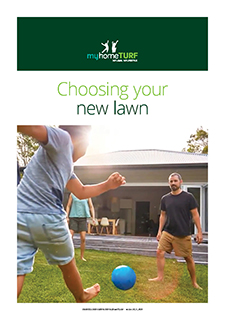Broadleaf Carpetgrass – Is It the Right Grass for You?
This perennial warm-season grass is an appealing choice for homeowners in tropical parts of Australia – especially northern Queensland. With excellent shade but poor drought ...

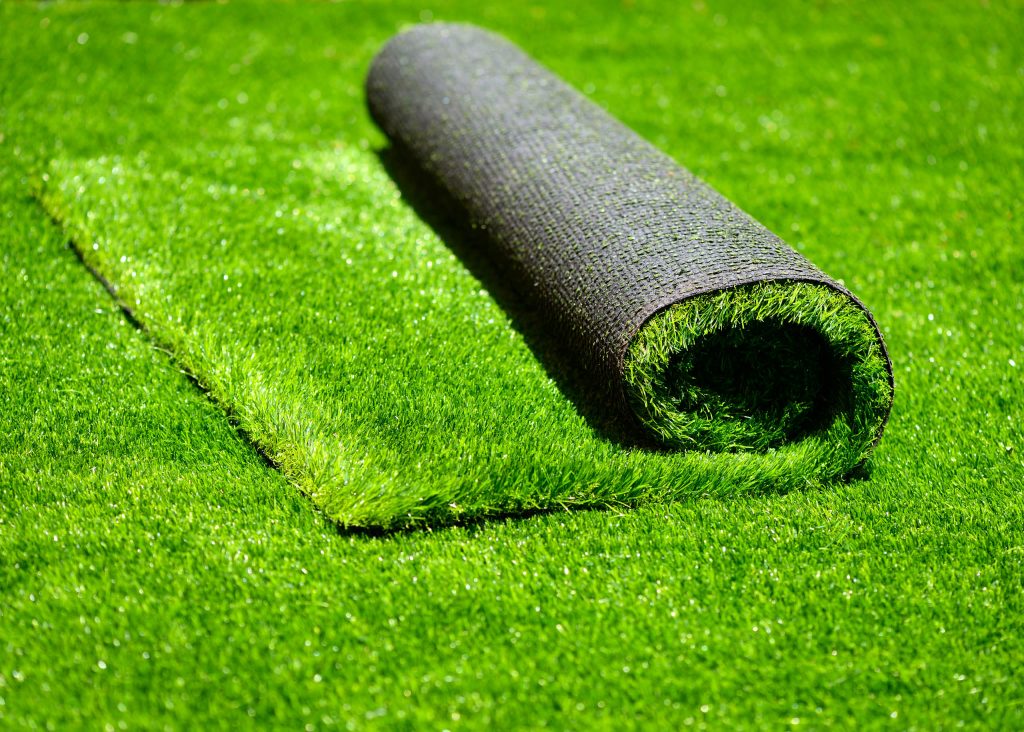 Synthetic Grass Lawns are an alternative to natural grass for people who may be seeking to save time and money on lawn care.
Synthetic Grass Lawns are an alternative to natural grass for people who may be seeking to save time and money on lawn care.
However, synthetic grass comes with its own set of pros and cons.
In this article, we will take a closer look at Synthetic Grass Lawns and examine the true costs of installation and maintenance, to determine if synthetic grass is right for you.
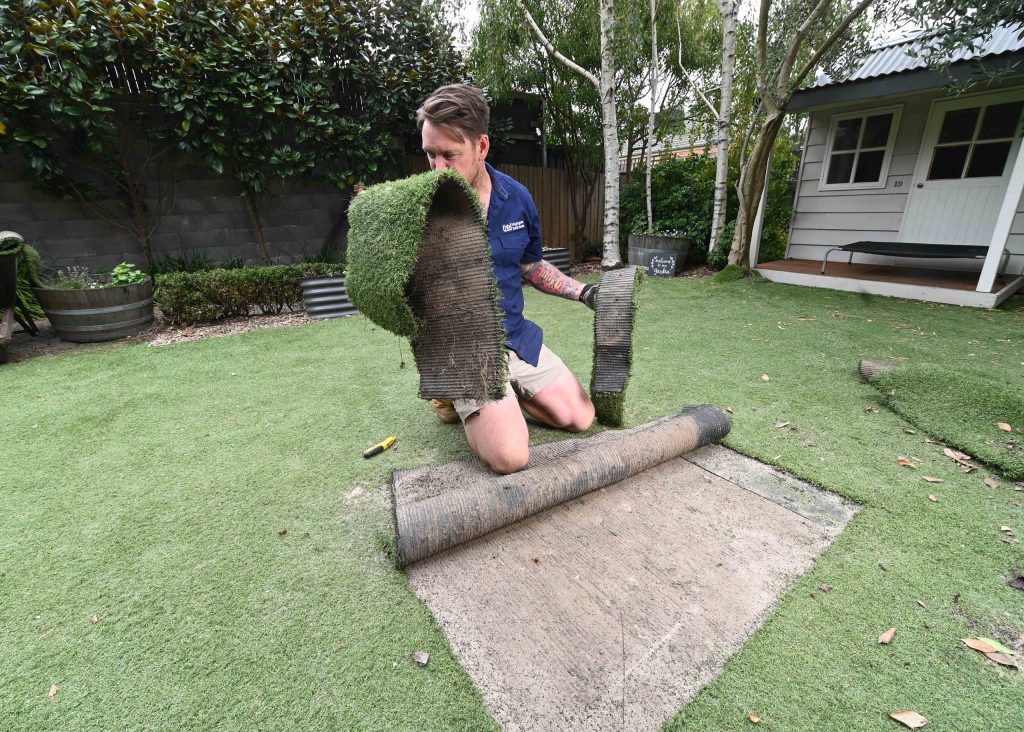 Synthetic grass, also commonly known as synthetic turf or artificial turf, is a type of turf that is made from synthetic materials. Synthetic grass was first invented in the 1960s to replace natural grass that had difficulty growing in sports stadiums. Synthetic grass is now used in a variety of applications, including sports fields, residential lawns, and commercial landscaping.
Synthetic grass, also commonly known as synthetic turf or artificial turf, is a type of turf that is made from synthetic materials. Synthetic grass was first invented in the 1960s to replace natural grass that had difficulty growing in sports stadiums. Synthetic grass is now used in a variety of applications, including sports fields, residential lawns, and commercial landscaping.
There are three main types of synthetic turf: unfilled, filled, and dressed.
Unfilled turf is typically used for sports due to its short pile height and dense blade count. This type of turf is usually made from nylon.
Filled turf has added filling materials such as sand, clay, or rubber granules in order to give the blades more support.
Dressed turf is a derivative of filled turf and is shorter and denser than the standard filled turf. This type of turf is typically used for high-traffic areas, as it can withstand more wear and tear.
Synthetic grass can be laid in any climate, is easy to install and does not require mowing, watering or fertilising, which may be appealing to homeowners looking to achieve a green lawn all year round.
Synthetic grass has many benefits over natural grass, including being more durable, requiring less maintenance, and being more resistant to pests and diseases. It is especially practical in areas of low rainfall or where there are strict water restrictions, as it does not require watering in order to maintain its green appearance.
Synthetic grass is an environmentally considerate choice, as it is typically made from recycled materials. It can also be a practical choice: it provides a more consistent playing surface than natural grass, it looks ‘green’ all the time, and it can be a cost-effective choice, with quality synthetic grasses known to last up to 15 years before needing to be replaced.
While synthetic grass has many benefits, surprisingly synthetic grass can require a lot of maintenance in order to keep it looking in tip-top condition.
Synthetic turf needs regular cleaning to prevent the build-up of leaves and debris, which can cause drainage problems. Sweeping of the surface should be done weekly. If leaves, tree flowers, pine needles and other debris are left on the surface for any length of time they can break down, forming a drainage-inhibiting skin within the surface which can encourage the growth of algae and moss.
Regular cleaning helps to remove any dirt or grit which could potentially damage the turf. There are a number of different ways to clean synthetic turf, including using a broom, hose, or even a pressure washer. However, it is important to avoid using harsh chemicals or cleaners, as these can damage the turf.
Regular grooming of synthetic turf is important to prevent the deterioration of its appearance and characteristics, and keep the surface as even and uniform as possible. This can be done with a mechanical brush or a power broom.
Synthetic turf should also be raked on a regular basis to remove leaves, twigs, and other organic debris. Raking also helps to redistribute infill material and maintain an even playing surface.
Finally, you should spray your synthetic turf with water on a regular basis to keep it cool and prevent dirt and dust from buildup.
Algae and moss can be unsightly on synthetic turf, and if left unmanaged, can cause permanent damage. Use a stiff broom to dislodge the algae or moss, and then treat the affected areas with a solution of bleach and water. Be sure to rinse the area afterwards with clean water to remove any residual bleach.
Alternatively, your turf can be treated with a fungicide designed for this purpose.
Although they are not as prevalent in synthetic turf as they are with natural grass, weeds can still appear from time to time. It is important to remove weeds as soon as they appear to prevent them from spreading. The best way to do this is to pull them up by the root by hand or using a weeding tool. If the weed has already gone to seed, you should also remove the seeds from the area to prevent them from germinating.
You should inspect the joints and seams of your synthetic turf on a regular basis, looking for any signs of looseness, separation, or gaps, which could cause a loss of pile, or pose a safety risk to users. Repair any damage promptly to avoid long term damage to your turf.
Filled synthetic lawns need the correct level of infill in order to maintain their bouncy, realistic feel. This also helps to protect the grass fibres from damage. Over time, infill can be lost through wear and tear, wind, and rain, so you should check the infill levels on a monthly basis and top up as needed. High traffic areas may need to be topped-up more regularly.
Power brushing uses rotating brushes to loosen and remove any build-up of dirt, debris, or other materials that can accumulate on the synthetic grass over time. Many manufacturers recommend power brushing every six months in order to keep the rubber particles mobile and the carpet fibres upright.
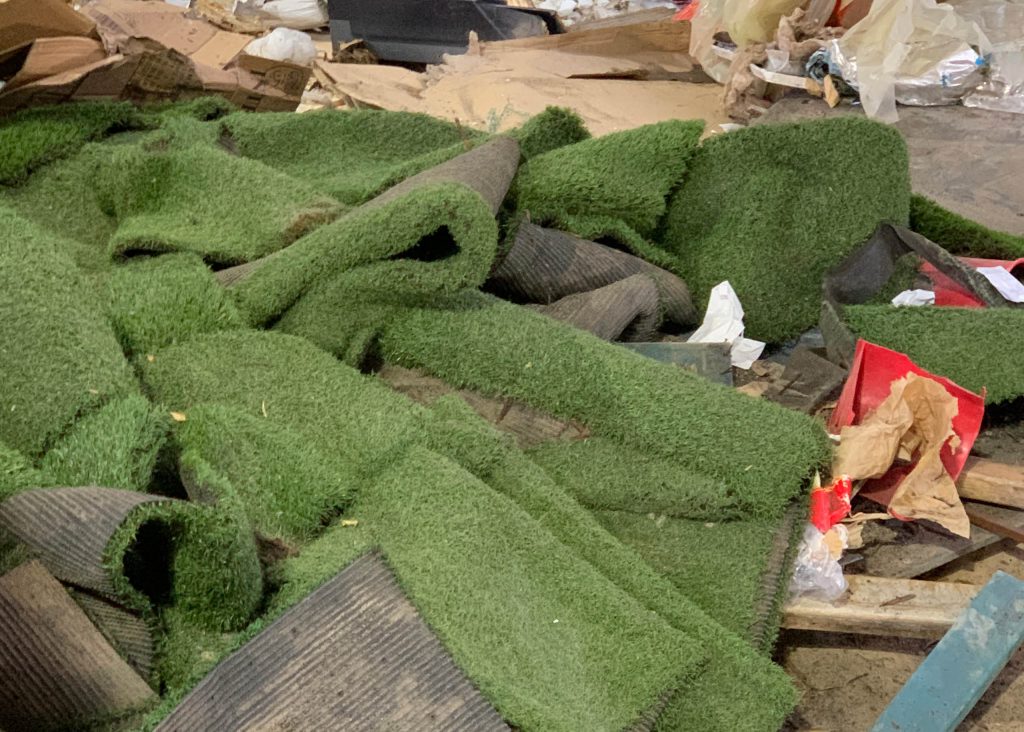 While synthetic grass may seem like a low-maintenance alternative to traditional turf, it actually requires quite a lot of care to keep it looking its best.
While synthetic grass may seem like a low-maintenance alternative to traditional turf, it actually requires quite a lot of care to keep it looking its best.
Without regular cleaning and maintenance, synthetic lawns can degrade more quickly and may not last as long as expected. If you’re a pet owner, you’ll need to clean your artificial turf more regularly to avoid urine seeping into the drainage holes of the rubber matting and creating an unpleasant odour. Over time, the grass – irrespective of how well you care for it, will start to look tatty and worn, especially in high traffic areas, losing the lush look that you expect.
Synthetic lawns can also present a safety hazard for your family and pets. On hot summer days, synthetic grasses can heat up to extremely high temperatures and have been known to cause bad burn injuries to people and pets that come into contact with it.
During the intense Australian summer heat, synthetic turf can be up to 30 degrees C hotter than natural turf.
Synthetic turf can be more expensive than natural turf and is not suitable for steep slopes. And despite its perceived environmental advantages, most artificial turfs only last about 10 years and are not biodegradable, therefore ending up in landfills at the end of their life where they sit forever!
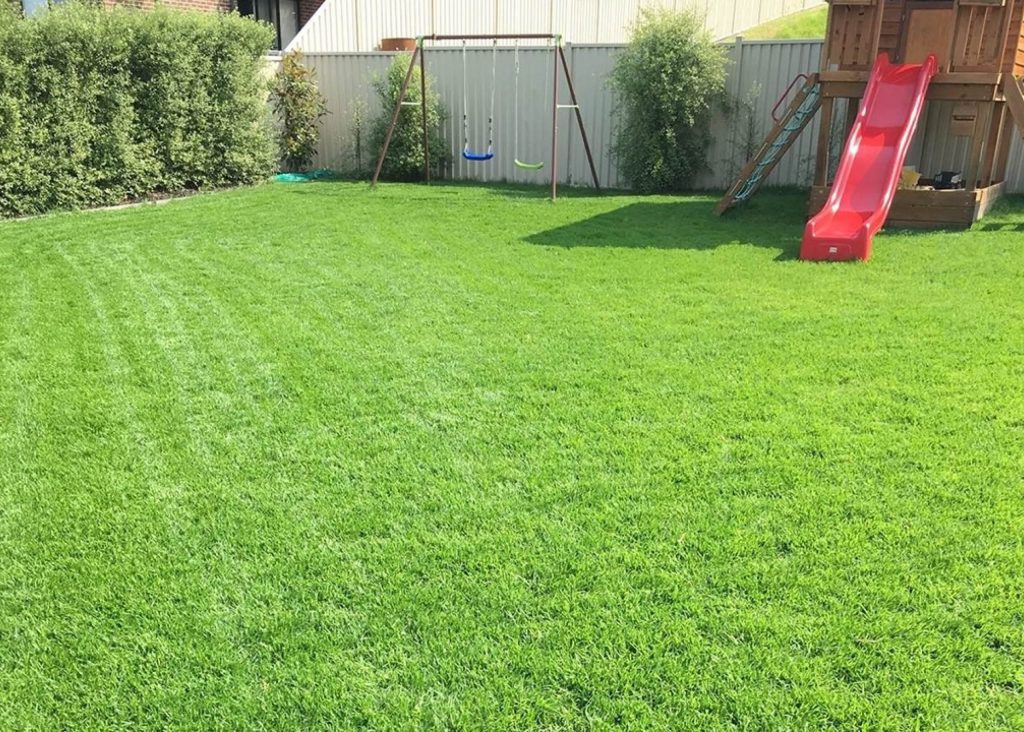 Natural turf has a multitude of benefits over synthetic surfaces.
Natural turf has a multitude of benefits over synthetic surfaces.
It has a cooler feel, particularly in summer, and is softer and more forgiving, making it safer for children to play on. Natural turf has a pleasant smell, particularly when it has been freshly mown, and if well maintained makes a magnificent backdrop to the family home.
From an environmental perspective, natural turf also has many benefits. Grass helps to absorb carbon dioxide and other greenhouse gases, which can contribute to the fight against climate change. In addition, turf or grass helps to regulate water levels in the soil, preventing both floods and droughts. Modern drought-resistant grass types have been developed which can thrive in Australian conditions, making them a more sustainable option for Australian gardens.
In fact, the cooling effect of a real lawns is just as effective if not better than trees.
Many people choose to install synthetic turf in their yards because they believe it will save them money in the long run. However, the initial cost of natural turf is considerably lower than synthetic, and with proper care, a natural lawn will last a lifetime.
A natural turf lawn is a beautiful addition to any home, but for some people, the need for ongoing maintenance is considered a significant disadvantage over synthetic alternatives.
Maintenance costs for natural turf can be higher than for artificial turf, due to a commitment to regular mowing, watering, and fertilising. Costs associated with managing weeds, disease, and pest control can also be a deterrent for homeowners.
While natural turf can be more susceptible to wear and tear, there are a number of wear tolerant varieties on the market, and most lawns are self-repairing with the right care.
Synthetic grass and natural grass both have their pros and cons, and the debate on which is best has been around for a long time.
Generally, natural turf comes out the overall winner for most Australian settings. This is because natural grass is much cooler in summer, softer to walk on, and generally looks more attractive. It is also cheaper to install and provides a large number of environmental benefits. It is also the safest option, as it does not overheat, and poses a risk of burns to pets and family.
However, there are some instances where synthetic grass might be more appropriate. Synthetic grass has medium maintenance and can withstand heavy wear and tear. Synthetic turf is also ideal in areas where natural grass won’t grow – for instance, in complete shade.
Synthetic grass can be a viable option in some circumstances, especially if you’re looking for a solution that requires little watering and mowing. But they can pose safety issues, especially in summer, and require regular cleaning, grooming and repair to keep them in top condition. Most synthetic turfs only last about 10 years and are not biodegradable, therefore ending up in landfills at the end of their life where they sit forever!
For a more user-friendly, environmentally-conscious option, consider the range of natural turf options out there – they are not only cheaper to install, but in the long run, with the right care, will add value to your home.
For expert advice on the right grass selection for your home, speak to your local turf farmer or supplier. Use Find a Turf Supplier to locate a supplier in your area.
Sign up for our Newsletter to receive your free guide.
